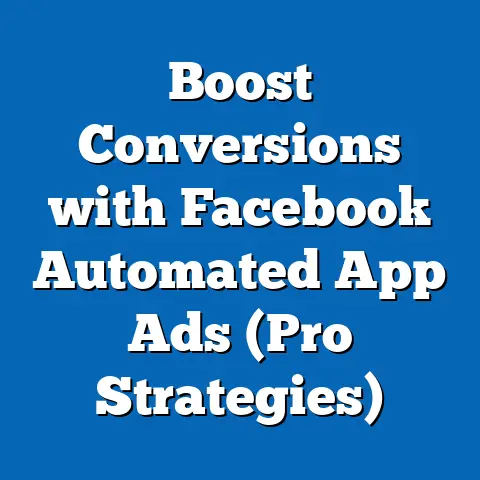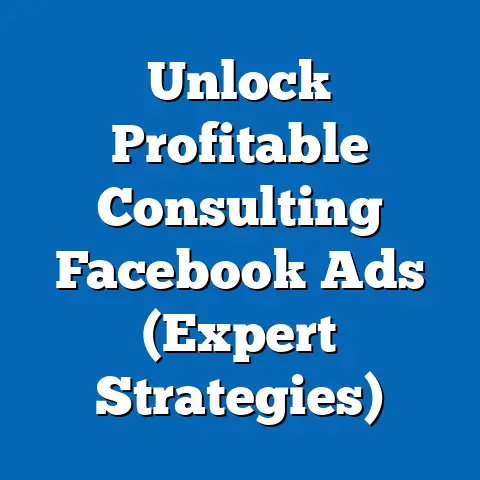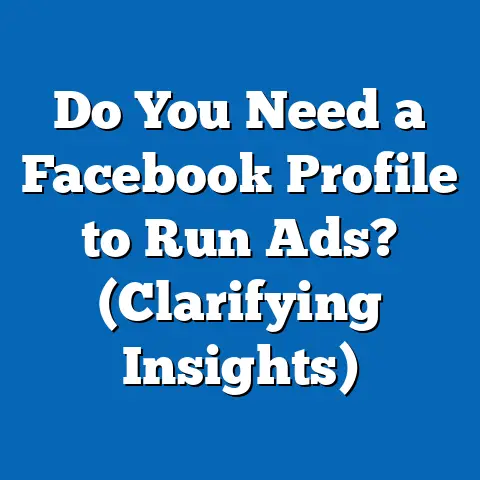Remove Facebook Ads Confidently (Expert Guide Unveiled)
The Future of Facebook Ads: Trends and Statistics
The future of Facebook advertising is shaped by rapid technological advancements, shifting user behaviors, and regulatory changes. As of 2023, Meta reported that Facebook has over 3 billion monthly active users worldwide, making it one of the largest advertising platforms globally (Meta Investor Report, Q2 2023). Advertising revenue for Meta reached $31.5 billion in the second quarter of 2023 alone, underscoring the platform’s reliance on ads to sustain its business model.
However, trends indicate a growing pushback against intrusive advertising. A 2022 survey by Pew Research Center found that 74% of internet users feel frustrated when content is irrelevant or overly personalized, with many citing ads as a primary annoyance. Additionally, the rise of ad blockers—used by over 27% of global internet users according to Statista (2023)—signals a demand for control over online experiences.
Looking ahead, privacy regulations like the European Union’s General Data Protection Regulation (GDPR) and California’s Consumer Privacy Act (CCPA) are reshaping how platforms handle user data for ads. By 2025, experts predict that over 60% of global internet users will be covered by stringent privacy laws, forcing platforms like Facebook to adapt with more transparent ad systems (Forrester Research, 2023). This regulatory shift, combined with Apple’s App Tracking Transparency (ATT) framework, which has already cost Meta an estimated $10 billion in ad revenue in 2022 (Bloomberg), points to a future where users have greater power over ad exposure.
Demographic Insights: Who Wants to Remove Facebook Ads?
Understanding who seeks to remove or limit Facebook ads is critical to grasping the broader movement. According to a 2023 report by eMarketer, younger users aged 18–34 are the most likely to express ad fatigue, with 62% stating they actively seek ways to reduce ad exposure on social media platforms. This demographic, often tech-savvy and privacy-conscious, prioritizes control over their digital footprint.
In contrast, older users (aged 55+) are less likely to take action against ads, with only 29% expressing frustration, per the same eMarketer study. This group often lacks familiarity with ad-blocking tools or platform settings, highlighting a digital literacy gap. Geographically, users in Europe are more proactive in managing ads due to GDPR awareness, with 41% adjusting privacy settings compared to 28% in North America (Statista, 2023).
Gender differences also emerge, though less pronounced. A 2022 survey by YouGov found that 54% of women versus 48% of men reported annoyance with targeted ads, often citing privacy invasion as a concern. These demographic patterns suggest that solutions for removing or managing ads must account for varying levels of tech awareness and cultural attitudes toward privacy.
Historical Context: The Evolution of Facebook Ads and User Response
To appreciate current trends, it’s essential to examine the history of Facebook advertising and user pushback. When Facebook introduced ads in 2007, they were rudimentary, sidebar placements with minimal targeting. By 2012, the platform’s ad revenue soared to $5 billion annually as it rolled out sophisticated algorithms and News Feed ads (Meta Historical Data, 2023).
User response evolved alongside these changes. Early complaints focused on ad relevance, but by the late 2010s, concerns shifted to privacy following high-profile scandals like Cambridge Analytica in 2018, which exposed data misuse affecting 87 million users (FTC Report, 2019). This event catalyzed a 30% spike in searches for “how to remove Facebook ads” between 2018 and 2019, according to Google Trends data.
Historically, ad-blocking software usage grew from 15% of internet users in 2015 to 27% by 2023 (Statista). Meanwhile, Facebook introduced tools like “Ad Preferences” in 2016 to give users more control, though adoption remains low—only 18% of users regularly adjust these settings (Pew Research, 2022). This historical tension between platform monetization and user autonomy sets the stage for today’s ad management strategies.
Why Remove Facebook Ads? Key Motivations
The desire to remove or limit Facebook ads stems from several well-documented concerns. First, privacy remains a top issue. A 2023 survey by Cisco found that 81% of internet users worry about how their data is used for targeted advertising, with many citing Facebook as a primary concern.
Second, ad fatigue impacts user experience. Research from HubSpot (2023) indicates that 57% of social media users feel overwhelmed by the frequency of ads, with 43% reporting they scroll past or ignore them entirely. This saturation reduces engagement, pushing users to seek ad-free experiences.
Finally, irrelevant or intrusive ads frustrate users. According to a 2022 Nielsen study, 66% of consumers find personalized ads helpful only when relevant, while poorly targeted ads lead to negative brand perceptions. These motivations—privacy, fatigue, and relevance—drive the need for effective ad management solutions.
How to Remove Facebook Ads Confidently: Step-by-Step Guide
Navigating Facebook’s ad ecosystem can be complex, but with expert strategies, users can regain control. Below, we break down actionable steps for individuals and businesses to manage or remove ads confidently. Each method is supported by platform policies and tools as of 2023.
1. Adjust Ad Preferences on Facebook
Facebook allows users to customize ad experiences through the “Ad Preferences” tool. Located under Settings > Ads, this feature lets users view why they see specific ads and limit data usage. For instance, users can disable ads based on off-Facebook activity, a setting used by only 22% of users despite its availability since 2020 (Meta Transparency Report, 2023).
To maximize impact, remove interests or categories that trigger unwanted ads. While this won’t eliminate ads entirely, it reduces irrelevant content. Meta reports that users who adjust preferences see a 15% improvement in ad relevance over time.
2. Use Facebook’s “Hide Ad” and Feedback Options
For immediate control, users can hide specific ads by clicking the three-dot menu on any ad and selecting “Hide Ad.” This action prompts Facebook to show fewer similar ads, though it requires consistent feedback. A 2022 study by Digital Trends found that users who hide 10 or more ads weekly notice a 20% reduction in repetitive content within a month.
Additionally, selecting “Why Am I Seeing This Ad?” provides transparency into targeting criteria. Users can then opt out of specific data points, such as location or browsing history, to further refine their feed.
3. Opt for Facebook Premium (Ad-Free Experience)
Meta introduced a subscription-based, ad-free version of Facebook in select regions in 2023, primarily in Europe, to comply with GDPR. Priced at approximately €9.99 per month, this option eliminates ads entirely for subscribers (Meta Press Release, November 2023). While not yet available globally, early data shows a 5% adoption rate among eligible users, per Statista (2023).
This model reflects a broader trend toward premium, ad-free social media experiences. For users unwilling to pay, alternative methods remain essential.
4. Leverage Browser Extensions and Ad Blockers
Ad-blocking tools like uBlock Origin or AdBlock Plus can filter out Facebook ads on desktop browsers. As of 2023, over 300 million users worldwide use such extensions (Statista). However, Meta actively counters these tools by updating its platform, and mobile apps remain unaffected unless rooted—a risky process.
Users should note that ad blockers may violate platform terms of service. Ethical considerations aside, this method offers a technical workaround for desktop users seeking an ad-free experience.
5. Limit Data Sharing and Third-Party Tracking
Reducing data shared with Facebook minimizes targeted ads. Under Settings > Privacy, users can disable off-Facebook activity tracking, which prevents Meta from collecting data from third-party sites. According to Meta’s 2023 Transparency Report, disabling this feature reduces ad personalization by up to 40%.
Additionally, clearing cookies and using private browsing modes limits tracking. While not foolproof, these steps align with privacy best practices recommended by the Electronic Frontier Foundation (EFF).
6. Business Perspective: Managing Ads as an Advertiser
For businesses, removing or adjusting ads involves pausing campaigns or refining targeting to avoid user annoyance. Meta’s Ads Manager allows advertisers to monitor ad fatigue metrics, with studies showing that ads shown more than five times to the same user lose 30% of engagement (Meta Business Insights, 2023). Pausing underperforming campaigns or using frequency caps can improve user experience while maintaining ROI.
Businesses should also respect user opt-outs. GDPR mandates that EU users can withdraw consent for data usage, a rule enforced with fines up to €20 million or 4% of global revenue (EU Commission, 2023). Compliance not only avoids penalties but builds trust.
Data Visualization Description: Trends in Ad Management
To illustrate the growing demand for ad control, imagine a line graph titled “Global Ad Blocker Usage (2015–2023).” The X-axis represents years, and the Y-axis shows the percentage of internet users using ad blockers. The line steadily rises from 15% in 2015 to 27% in 2023, based on Statista data, with a sharp increase post-2018 following privacy scandals.
A second bar chart, “Demographic Ad Fatigue by Age Group (2023),” compares frustration levels across age brackets using eMarketer data. Bars for 18–34 (62%) tower over 55+ (29%), visually emphasizing generational differences. These visualizations would help readers grasp the scale and demographic nuances of ad management trends at a glance.
Challenges and Limitations in Removing Facebook Ads
Despite available tools, challenges persist in fully removing Facebook ads. First, Meta’s business model relies heavily on advertising, with 98% of its revenue tied to ads in 2023 (Meta Financials). This incentivizes the platform to maintain ad presence, even for users who adjust settings.
Second, technical barriers limit effectiveness. Ad blockers don’t work seamlessly on mobile apps, where 88% of Facebook users access the platform (Meta Usage Report, 2023). Rooting devices or using unofficial apps poses security risks, as warned by cybersecurity experts at Norton.
Finally, user education remains a hurdle. Only 18% of users engage with ad preference tools, often due to complex interfaces or lack of awareness (Pew Research, 2022). Overcoming these challenges requires a combination of user effort, platform transparency, and regulatory support.
Broader Implications: Privacy, Engagement, and the Future of Social Media
The push to remove Facebook ads reflects deeper shifts in digital culture. Privacy concerns are no longer niche; they shape user behavior and policy worldwide. A 2023 Deloitte survey found that 71% of consumers are willing to switch platforms if data practices seem invasive, signaling a potential tipping point for ad-driven models.
For Meta, balancing user satisfaction with revenue is critical. The introduction of ad-free subscriptions in Europe may expand globally, but at €9.99 per month, affordability remains a barrier for many. eMarketer predicts that by 2027, 10–15% of social media users in high-income regions could adopt premium plans, creating a two-tiered system of free (ad-supported) and paid (ad-free) experiences.
User engagement also hangs in the balance. Overloading users with ads risks alienating them, as seen in a 12% drop in daily active users in North America between 2021 and 2022 (Meta Investor Report). Platforms must innovate—perhaps through less intrusive ad formats or enhanced control tools—to sustain growth.
Finally, the ad management movement ties into broader digital literacy. Educating users on privacy settings and data rights empowers them to navigate platforms confidently. Governments and advocacy groups, like the EFF, play a role in pushing for transparency, ensuring that control over ads isn’t just a privilege for the tech-savvy.
Conclusion: Navigating the Ad Landscape with Confidence
Removing or managing Facebook ads confidently is both a personal and collective journey. As this guide demonstrates, tools like ad preferences, feedback options, and premium subscriptions offer viable paths, though challenges like platform resistance and technical barriers persist. Backed by data—such as the 27% global ad blocker usage (Statista, 2023) and 62% ad fatigue among younger users (eMarketer, 2023)—the demand for control is undeniable.
Looking forward, the intersection of privacy laws, user behavior, and platform innovation will redefine digital advertising. Whether through regulatory pressure or market-driven solutions like ad-free tiers, the future promises more user autonomy. For now, individuals and businesses can take proactive steps to tailor their Facebook experience, contributing to a broader movement toward a balanced, user-centric internet.






